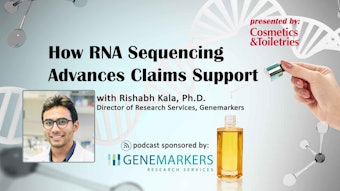
To read this article in its entirety, click through to your March 2020 digital magazine. . .
The human body plays host to a remarkable number of microbes. These imperceptibly small passengers make their homes on skin and within the digestive tract, and despite the fact that they number in the trillions, they are for the most part largely unnoticed throughout life.
Yes, trillions of bacteria live in a peaceful symbiotic relationship with the body. To put this into perspective, a large city may house a few million humans, and the entire human population of the world numbers in the very low billions. That means the number of microorganisms living on and in the human body can exceed the entire human population of the world by three orders of magnitude, making consumers the rulers and caretakers of their own ecosystem of microbes.
Collectively, the group of microbes people carry around with them is referred to as the microbiome. To most individuals, the idea of being the caretaker of their own personal microbiome is unnerving, especially since it is their own body that acts as a foundation for that microbiome. The prospect of carrying a few trillion microbes on or within your person can also make you feel far from clean or healthy. However, there are several important health benefits that come with this relationship, including tuning your immune system, helping with digestion and the generation of important dietary microbial fermentation products that your body can use. In this way, the relationship is very symbiotic—the microbial load provides the body with a series of useful services in exchange for hosting them.
One of the reasons this relationship between the body and microbiome can work is the diversity in types of microbes on the body. In a way, the microbes compete with each other for resources, and this competition tends to keep their numbers in check and maintains a good balance of different microbial types, which can be beneficial for the body. However, problems arise when this microbial diversity becomes unbalanced, and one type of microbe begins to dominate an area of the body. This problem is compounded when the microbe is an especially virulent type, such as Staphylococcus aureus. In this context, the labeling of a microbe as virulent implies it can inflict severe damage to the host, and this label aptly applies to S. aureus which can be a formidable and deadly pathogenic bacterium.
S. aureus is not a typical member of the skin microbiome; it is found on just one in every five healthy individuals.1 However, in certain dermatological conditions, the carriage rate of S. aureus on the skin can be significantly increased. One such condition is atopic dermatitis (AD), where the carriage rate increases to seven out of every 10 individuals, with an increased S. aureus population observed in sections of the skin specifically affected by AD.2 In fact, there is a very strong correlation between the severity of AD symptoms and the density of S. aureus found within the lesion.2 It is worth noting since S. aureus is not found in all individuals suffering from AD, that this microbe is not the cause of the disease. Instead, it appears this bacterium can take advantage of the compromised area of skin in AD lesions to thrive. As a consequence of the pathogens generated by this organism, the AD lesions will further worsen—leading to a more severe presentation of the condition.
AD is a skin condition associated with chronic inflammation and a dry, itchy rash. It is also associated with impaired skin barrier function, with the most common molecular markers being reduced filaggrin and ceramide production. It is these areas of impaired barrier functioning on the skin that appear to be susceptible to S. aureus, and once it has invaded in sufficient numbers, the bacterium will activate its pathogenic arsenal and release toxins that can damage and destroy the local cellular environment.
While typical treatment for AD involves topical steroids and a course of antibiotics, these only offer a temporary reprieve from the symptoms. Individuals who suffer from AD often face a lifelong cycle of managing disease flare-ups and the constant use of prescription topical steroids. Unfortunately, antibiotics can take a toll on the skin with prolonged use. Therefore, it is highly desirable to provide alternative methods to manage the problem of AD, and ideally, these alternative methods should be easily accessible and offer modes of action that are different from current treatments. From a mechanistic point of view, the process of AD, along with the complications brought on by S. aureus, does provide potential targets for intervention—some of which can be investigated using in vitro methods.
Barrier Function and Filaggrin
One hallmark symptom of AD is epidermal barrier dysfunction,3 which is often associated with a deficiency of the important epidermal protein filaggrin. In the corneocyte, filaggrin will aggregate keratin filaments that help to structure the extracellular lipid matrix in the stratum corneum.4 In addition, the normal degradation products of filaggrin generate some of the natural moisturizing factors that contribute to maintaining hydration and pH in the stratum corneum.5 Thus, either the absence of filaggrin or a reduction in its levels leads to: a loss in barrier function at the level of the stratum corneum, a reduction in the skin’s natural moisturizing factors, and a regional increase in the pH of the skin.
While changes in filaggrin are more than enough to prompt the onset of AD, these changes in the skin also provide S. aureus with an optimal growth area. This bacterium can adhere more readily to the corneocytes in barrier-compromised areas,6 and the increased pH is advantageous to its growth.7 Therefore, the flare ups of AD inadvertently provide an optimal breeding ground for S. aureus and, in turn, the presence of this organism can dramatically increase the severity of the AD symptoms.
Reductions in filaggrin can occur in AD for a variety of reasons. In some cases, there is a genetic issue involving a direct mutation in the filaggrin gene, which either causes the formation of an unusable form of filaggrin or prevents its formation entirely. In other cases, the decrease in filaggrin is due to other issues associated with atopic dermatitis, such as an increased local level of Th2 cytokines (i.e., IL-4, IL-5, IL-6, IL-9, IL-13), which can directly reduce the expression of filaggrin or even physically strip away the filaggrin through the simple act of scratching itchy skin.4 Thus, considering the importance of filaggrin to maintaining barrier function and acting as the first line of defense against S. aureus colonization, it is a good target to screen materials for use in treating AD.
. . .Read more in the March 2020 digital edition. . .
References
- Paller, A.S., et al.(2019). The microbiome in atopic dermatitis. J Allergy and Clinical Immunology 143(1) 26-35.
- Totte, J.E., et al. (2016). Prevalence and odds of Staphylococcus aureus carriage in atopic dermatitis: A systemic review and meta-analysis. Brit J Derm 175 687-695.
- Kim, J.E. and Kim, H.S. (2019, Apr 2). Microbiome of the skin and gut in atopic dermatitis: Understanding the pathophysiology and finding novel management strategies. J Clinical Med 8(4) pii E444.
- Cepelak, I., Dodig, S. and Pavic, I. (2019). Filaggrin and atopic march. Biochemica Medica (Zagreb) 29(2) 1-12.
- Sandilands, A., Sutherland, C., Irvine, A.D. and McLean, W.H. (2009). Filaggrin in the frontline: Role in skin barrier function and disease. J Cellular Sci 122 1285-94.
- Fleury, O.M., et al. (2017, May 23). Clumping factor B promotes adherence of Staphylococcus aureus to corneocytes in atopic dermatitis. Infection and Immunity 85(6) pii e00994-16.
- Miajlovic, H., Fallon, P.G., Irvine, A.D. and Foster, T.J. (2010). Effect of filaggrin breakdown products on growth of and protein expression by Staphylococcus aureus. J Allergy and Clin Immunol 126 1184-1190.










